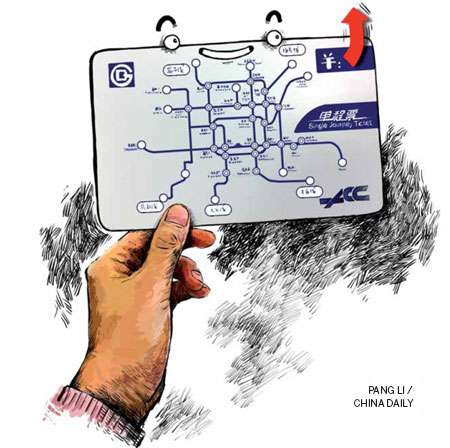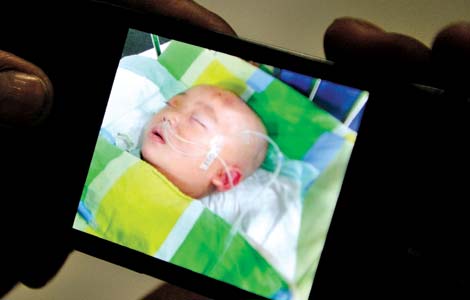Who's being taken for a ride?
Updated: 2013-12-20 10:08
By Raymond Zhou (China Daily Europe)
|
|||||||||||
Almost everyone loves low public transport fares and other subsidized services, but responsible citizens should consider the cost of such pricing policies
There is subsidizing and there is excessive subsidizing. Once you are entrenched in the latter, you gain a sense of entitlement that will blind you to the big picture.
Beijing's metro system is considering raising its price from the current flat fee of 2 yuan ($0.33; 0.24 euros) a ride to a distance-based fare during the rush hours. This is certainly an unpopular move and I'm surprised only 60 percent of respondents to a survey voiced their objection. Theoretically, all Beijing subway riders would flash a "No" sign, but the remainder could well be non-subway users or people in other cities who are envious of Beijing's ultra-low fares.
Beijing used to charge 3 yuan for a ride and add 2 more for some outlying lines. All this changed in the run up to the 2008 Olympics when bus fares were slashed by 60 percent and subway ones by at least a third. It was supposed to get people out of their cars and onto public transport.
It must have been quite successful because there is rarely an empty seat on a bus or a subway car, not even during off-peak hours. And some lines during the rush hours are so packed you won't forget it soon - if you are not a regular rider, that is.
It is preposterous to suggest that a higher fare will significantly thin rush-hour crowds. A majority of riders are commuters whose hours are determined by their employers. Maybe the retired, who are by nature price-conscious, will change their schedule, but it won't make a visible dent.
The 2008 reduction in fares was well intentioned but misguided. They were already very low, and reducing them further did not achieve the desired result of diverting car riders to the more environmentally friendly mode of traffic. What Beijing should have done at that time, with the installation of smart swiping sensors, was to introduce the distance-based fare, which is currently in use in almost every other Chinese city with metro lines.
Don't get me wrong. I'm not against subsidies for public transport. Unlike the taxi system, buses and subway have to be supported by municipal governments. Their prohibitive starting cost means no profit-oriented entity would take them on as a regular business. Yet they benefit the majority of the residents, plus domestic and foreign visitors. The London mayor took a subway ride in Beijing and was amazed at how cheap the fare was.
Beijing currently spends 18 billion yuan a year on subsidizing public transport, most of it going to the metro system. With municipal coffers flush with tax money, this does not sound like much. But economies go through cycles. We're living in the boom times, and what if there is a dip in tax money down the road? You cannot adjust bus and subway fares as you can fuel prices, so you'll need some sustainable plan - even for subsidies.
Beijing's fare system is not only out of touch with the cost structure, but way below that of any other city I know of. From my experience, London probably has the most expensive fare, with a subway ride higher than a Beijing taxi fare. Even Bangkok is more expensive than Beijing.
Two yuan in the current market is virtually negligible, especially for office workers who use it most heavily. I see it as a nominal charge.

This can wreak havoc with the consumer price index. I was in an economics forum when the fare was initiated and a speaker who was a consultant for a state-level decision-making body used Beijing's new low fare as a counterweight for the sharp rise in vegetable prices. I don't know how much transport weighs in the basket of goods and services when calculating inflation, but it has artificially dragged the figures down, rendering a picture that is rosier than it actually is.
There is an argument that low subway fares benefit ordinary people, and if this fund does not go to such a worthy cause it will go on dining and wining by corrupt officials. While it is true that the subsidy does not go to the privileged, it may not be an either-or case between these two choices. If it is between subsidizing an office worker's subway ride and an official's new Audi, I'm all for the former. But the real choice probably lies in allocating the amount to public transport or education or healthcare or helping the urban poor.
The law of diminishing marginal returns means that a subsidy should go to those programs that help those most in need of help. If you ask Beijing residents to vote for a rise in subway or bus fares, there is no way it's going to pass. It simply goes against common sense for people to desire a higher price for something that is not considered a luxury. But if you ask them to choose among several government programs that need funding, I'm sure most people would pick the right one. And very probably, extremely low subway fares will not be high on the list of priorities.
Even in a market economy, government subsidies are necessary for certain public projects. But the amount of subsidy should be calculated with profound knowledge in economics. It's not necessarily the lower the better.
Take performing arts. Governments at various levels essentially own all performing troupes in China, which results in heavily subsidizing every ticket to every show. What we get is not higher attendances for high-quality shows, but large numbers of empty seats for extravagant shows that run only a few times. The amount of waste is staggering.
On the other hand, the abolition of the nominal charge for many public museums and parks is a wise move. In the old days, these venues were grossly underutilized because the charge served as a deterrent to anyone who was not otherwise greatly interested. Free admission is necessary to cultivate the habit for museum visits and to allow the lowest of the social echelon, migrant workers, into city parks. It was a sad sight to see them lying outside a park getting a rest while park benches were conspicuously empty.
City officials in charge of public policies should study the theory of price elasticity - and of course the law of supply and demand - before making pricing decisions. When a change in price does not affect consumers' behavior, it has gone beyond the point where price as a leverage can work.
Sure, Beijing needs more subway lines and long-term investment in public transport. However, putting this in the same league with parks and recreation is to ignore the fundamental differences of the two services. Unless the city wants to flaunt largess in public transport as a unique form of welfare, it should consider both the pros and cons of pricing its bus and subway fares at close to gratuitous levels.
Contact the writer at raymondzhou@chinadaily.com.cn

(China Daily European Weekly 12/20/2013 page30)
Today's Top News
Chinese merchant killed during robbery in Russia
IPR courts 'would be helpful'
Liaoning's combat capability tested
GM corn rejection not to hurt market
US aircraft hit by gunfire in South Sudan
Memorials mark Lockerbie attack
H5N2 outbreak confirmed in N China
China's moon rover works stably
Hot Topics
Lunar probe , China growth forecasts, Emission rules get tougher, China seen through 'colored lens', International board,
Editor's Picks

|

|

|

|

|

|





